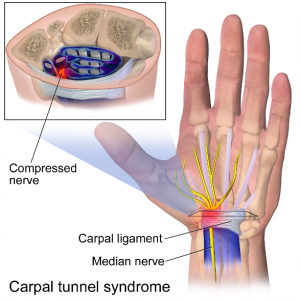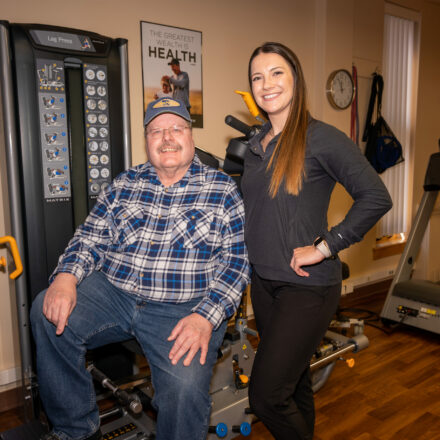
 By Steven Maser, M.D.
By Steven Maser, M.D.
What is carpal tunnel syndrome? Carpal means wrist, and the tunnel is formed by bones on the back and side of your wrist and a ligament on the palm side. Running through the tunnel are 9 tendons and a nerve, called the Median Nerve.
Symptoms
In carpal tunnel syndrome, the nerve gets pinched for a variety of reasons. This causes numbness or tingling in the distribution of the nerve (thumb, index, middle and half of the ring finger).
Initially, this numbness or tingling is usually intermittent. With time, the numbness may become constant. In more advanced cases, there can even be loss of the thumb muscle so that we can’t raise our thumb. This makes activities such as doing buttons very difficult. In some cases, the hand and wrist are painful. However, wrist pain without associated numbness or tingling is probably not carpal tunnel syndrome.
One of the most common symptoms is waking up at night with a hand that is numb and may feel swollen. People typically shake their hand or hang it down in an attempt to relieve the numbness.
Treatment Options
A night splint is an excellent first choice. You can get one at most pharmacies or surgical supply stores. It doesn’t have to fit perfectly. All it does is keep you from bending your wrist when you sleep. Bending your wrist like that puts more pressure on your nerve.
If you try a splint, a few days may not be adequate. Try it for a month before deciding whether it works. As long as the numbness is intermittent, then there’s no urgency to doing anything more than a splint. Of course, the splint isn’t always effective, and sometimes the numbness and night awakening are just too uncomfortable.
If the numbness is constant or if you have weakness, then don’t ignore that – please get checked by your doctor.
First, the physician will examine you. The nerves start up at the neck, and sometimes a pinched nerve in the neck can give similar symptoms. The physician will also examine you for other potential causes of your pain. There are specialized tests that your physician will do during your exam to evaluate your nerves. In some cases, the physician may send you to another specialist for a nerve test (EMG). This test measures the speed of the nerve. It tells us exactly where the problem is and gives us a good sense as to how bad it is.
Beyond Splints
Depending on the severity of the symptoms and how long you’ve had them, other options shown to be effective are corticosteroid injections or surgery to take the pressure off of the nerve. In patients where the symptoms come and go, a cortisone shot is often effective, although it is likely that symptoms will recur within a year – not always, though.
Surgery usually gets rid of the problem. It is possible that the symptoms will return, although this is actually very uncommon. The surgery is done on an outpatient basis. The surgeon opens up the ligament, relieving the pressure on the nerve. The ligament heals in a longer position so there is less pressure on the nerve.
It usually takes about 4-6 weeks until it feels like you “have your hand back.” A patient will typically have about 50 percent of strength by around 6 weeks. Some symptoms, such as some soreness in the palm, may linger, sometimes as long as six months.
Steven A. Maser, M.D., is a board certified orthopedic surgeon specializing in surgery of the hand. He also serves as Vice President and Medical Director of Monument Health Orthopedic & Specialty Hospital.
Doctors & Providers
Category
Blog PostsLatest News
More Like This



